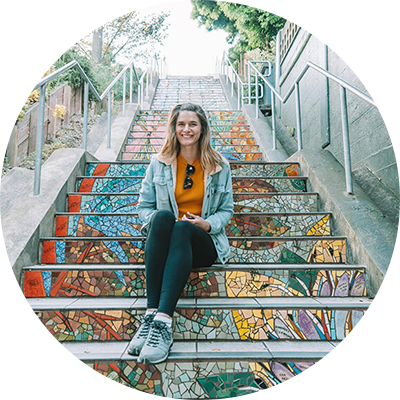Short on time? Our pick for the best screen house for camping is the Eureka Northern Breeze Aluminum Frame Screen House.
The best screen houses for camping – no matter what kind of adventure you have planned in the wild.
We all know that unwelcome feeling of bugs nibbling at our ankles once the sun goes down at camp and we’re just trying to get in a fun game night with the family.
I’ve turned in early more than a few times because the bugs wouldn’t stay away, even with the strongest bug spray.
Or, even during the day, you sometimes just want a shady place to eat lunch and relax out of the sun (and not in your hot tent).
Imagine the best parts of camping but without those itchy and annoying bug bites or sweaty downtimes in an enclosed tent.
Imagine enjoying quality time in nature in a clean and well-ventilated space that protects you from the elements outside of your main tent.
Sounds too good to be true, right? I thought so too until I discovered the magic of screen houses and how much they can up-level your average camping trip.
Screen houses are large, mesh-walled tent-like structures that are designed to be set up over a picnic table.
Their main purpose is to provide you with a space to get away from insects, rain, and hot sun while being able to sit, stand, and gather in a large group.
Think of it as a camping dining tent where you can prepare food and eat comfortably without swatting yourself silly from mosquito attacks.
That’s where this article comes in.
If you’re ready to take your next camping trip up another notch, we’ve rounded up our picks for the best screen houses for camping, no matter your group size or weather.
Note: this post contains affiliate links, which help run this site at no extra cost to you so I can keep providing free travel advice and tips.
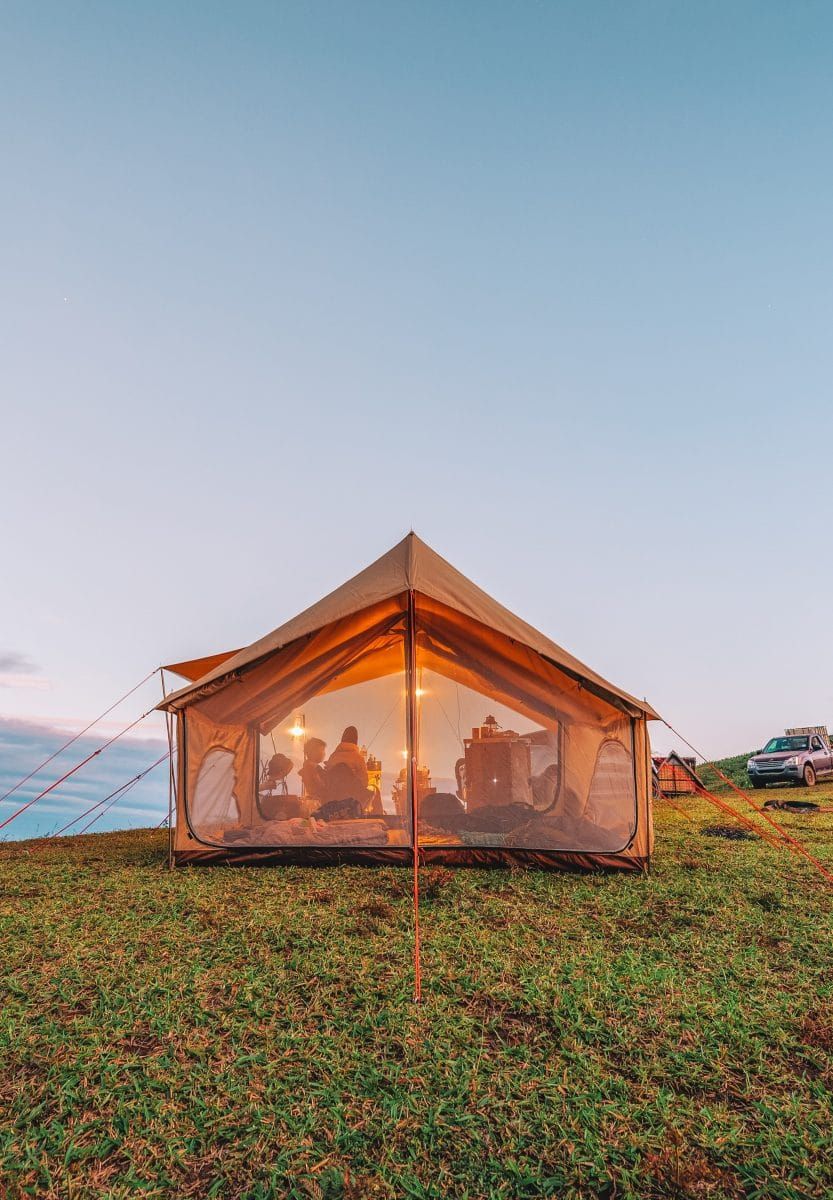
Here’s a quick look at our recommendations
- Best for Family Camping – REI Co-op Screen House Shelter
- Best for Small Groups – Coleman Instant Screen House Canopy Tent
- Best Instant Screen House – Alvantor Screen House
- Best Lightweight Screen House – Core Instant Screen House Canopy Tent
- Best for Rain – Eureka Northern Breeze Aluminum Frame Screen House
- Best for Wind – NEMO Victory Screenhouse
- Best Screen House with Floor – CLAM Quick-Set Pavilion Gazebo Screen Tent
- Best Budget Screen House – Ozark Trail Instant Screenhouse
- Most Durable Screen House – Coleman Screened Canopy Tent With Instant Setup
- Best Magnetic Screen House – Wenzel Magnetic Screen House
- Best for Backyard Camping – CAMPROS Screen House Room
- Best Screen House with Awning – Hasika All-Weather Diversified Screened Canopy
- Best Screen House for RV Camping – EAST OAK Screen House Tent Pop-Up
#1 REI Co-op Screen House Shelter
Best for Family Camping
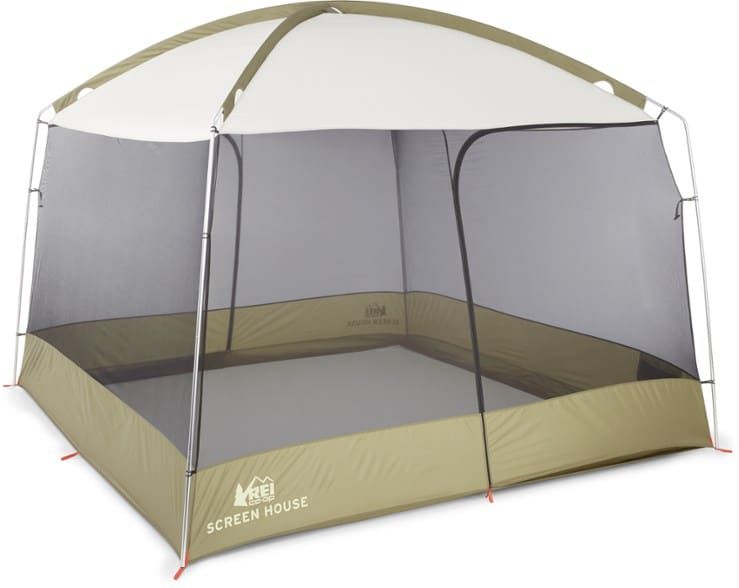
Our Rating: 5/5
Size: 100 sq ft
Peak Height: 7’
Weight: 13 lbs
The REI Co-Op Screen House Shelter is the best shelter for families for its overall quality and great organization (I love those pockets on the mesh walls).
Having pockets in camping gear is never a bad thing and if you’re camping with a family, being organized is a top priority.
Another thing families will appreciate; this screen shelter has color-coded pole sleeves, which help setup go faster. Nobody needs cold and wet children during a camping trip.
This REI shelter has a standard amount of room (100 square feet) with a peak height of seven feet, so lots of room for tall people.
Additionally, it has two doors and a solid fabric border around the bottom edge that helps keep bugs out.
Pro Tip: If you can bury the edge of the bottom fabric with soil or rocks, it really helps keep out bugs and keeps the screen house anchored.
As a bonus, this screen house doesn’t have a floor, which I prefer, so you can pick it up and move it over a picnic table.
Finally, this screen shelter is a little pricey, but one nice thing is that REI has a pretty generous return policy.
One thing I don’t love about this model is that the rain fly and guylines are sold separately.
There are stake loops at the bottom of the shelter, so it should withstand mild weather. Still, I’d recommend buying guylines for any serious wind.
PROS
- High quality
- Easy to set up
- Mesh pockets for organization
- Good return policy
CONS
- Expensive
- Rain fly and guylines are sold separately
#2 Coleman Instant Screen House Canopy Tent
Best for Small Groups
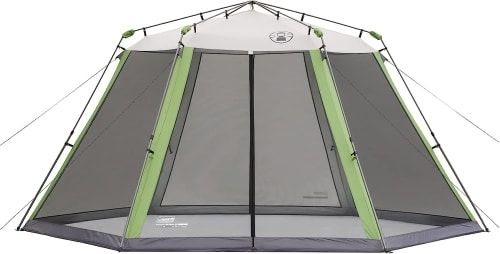
Our Rating: 4.5/5
Size: 195 sq ft
Peak Height: 7’
Weight: 18.3 lbs
If you’re taking a camping trip with a small group, the Coleman Instant Screen House Canopy Tent is a great choice.
At first glance, it looks like the square footage is quite a bit more than other screen houses in this article. However, because of the sloped angle of the tent walls, there’s less than 195 square feet of usable space.
That said, you can still comfortably fit 2-4 people in here as well as a small picnic set up and chairs.
The shaded part of this screen house is 41.6 square feet and has double-sided material that provides UPF 50 sun protection. Its center height is a good seven feet.
The tent also has two doors which are nice for a smaller screen house, so if space is cramped on the inside, there are multiple ways to get out.
Finally, this shelter features a very fast setup (60 seconds).
One thing to note with this screen tent is that since the covered part of the roof is so small, you may find yourself getting wet during rainstorms or more sun exposure during the summer heat.
Read our full guide to the best camping canopies.
PROS
- Fast setup
- Tall center height
- UPF 50 sun protection
CONS
- Small roof panel
#3 Alvantor Screen House
Best Instant Screen House
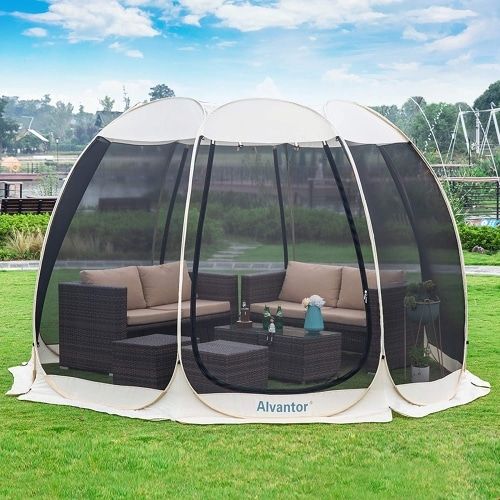
Our Rating: 5/5
Size: 100 sq ft
Peak Height: 7’’
Weight: 8.8 lbs
I can easily think of a few camping destinations (*cough* Tetons in July) where I literally couldn’t stand still because the mosquitos swarmed me instantly.
And now I won’t go back without an easy-up screen house.
The Alvantor Screen House features a foldable tent frame that springs up. It has two doors and 100 square feet of usable space.
This screen house is easy to set up, but note that it might be worth watching a video on how to fold it back into a disk shape.
I like that the Alvantor Screen House folds down flat so it’s easy to lay flat on other gear or store in a narrow space.
One downside to it being so lightweight is that it’ll blow around in the wind if you don’t stake it down.
Tightly woven mesh on this screen house keeps the bugs at bay. And UPF 50+ UV protection is perfect for the summer heat. Keep in mind though, that it won’t protect you from rain.
PROS
- Fast setup
- Flexible frame
- Folds down flat
- Tall peak height
- Sun protection
CONS
- May need to watch a tutorial video to fold it up
- The roof isn’t waterproof
#4 Core Instant Screen House Canopy Tent
Best Lightweight Screen House
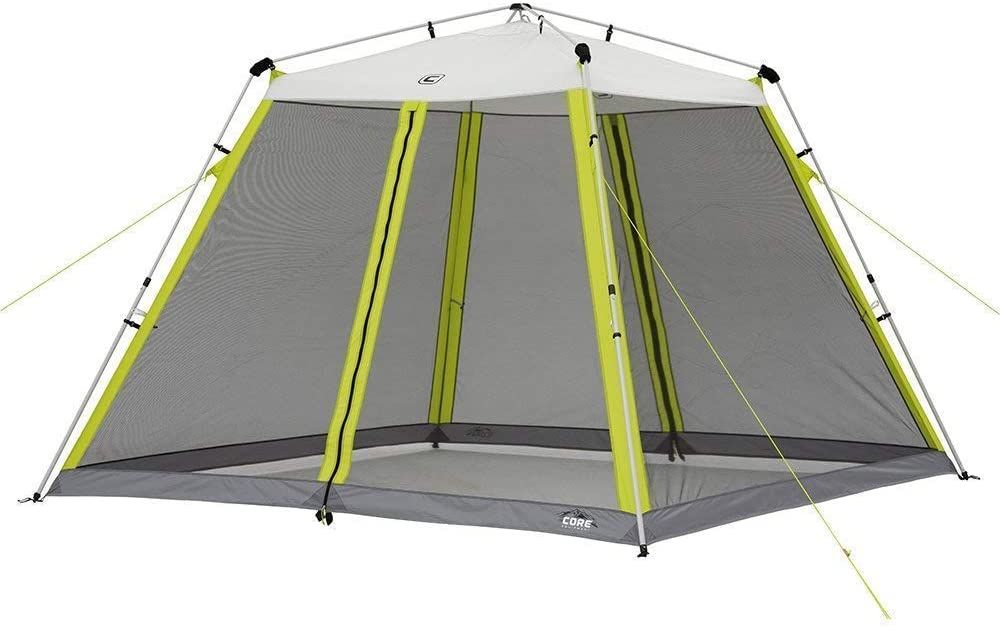
Our Rating: 4/5
Size: 100 sq ft
Peak Height: 7’
Weight: 8.1 lbs
Most folks using a screen house while camping aren’t going to be trekking into the wilderness.
However, if you’re planning to camp a little further from your vehicle, the Core Instant Screen House Canopy Tent is one of the lightest options for a portable screen house out there.
This screen tent features a speedy setup, and even though the tent is light (8.1 pounds), you still get 100 square feet of space and a seven-foot center height.
The roof of the tent is also listed as “heavy-duty 150D polyester,” which means that it has a Denier rating of 150.
The Denier rating measures how thick the individual fibers in the material are.
A 150D rating is around the lower end of what you might see in an outdoor backpack type of material, with the higher end being around 350D.
This means that it’ll do great in summer weather under light rain, but you may need an extra spritz of weatherproofing for more robust weather.
That said, the frame of this screen tent is alloy steel (aka a mix of steel and other metal), so it should be reasonably durable.
Lastly, the Core Instant Screen House Canopy Tent has sloped walls, which I don’t love because it reduces the amount of usable space inside the tent.
This tent is very reasonably priced, but for that reason, you might not receive as high-quality a product as other screen houses on this list.
PROS
- Fast set up
- Very lightweight
- Reasonably thick roof material
- Good price
CONS
- Sloped walls
- Potential quality issues
#5 Eureka Northern Breeze Aluminum Frame Screen House
Best for Rain
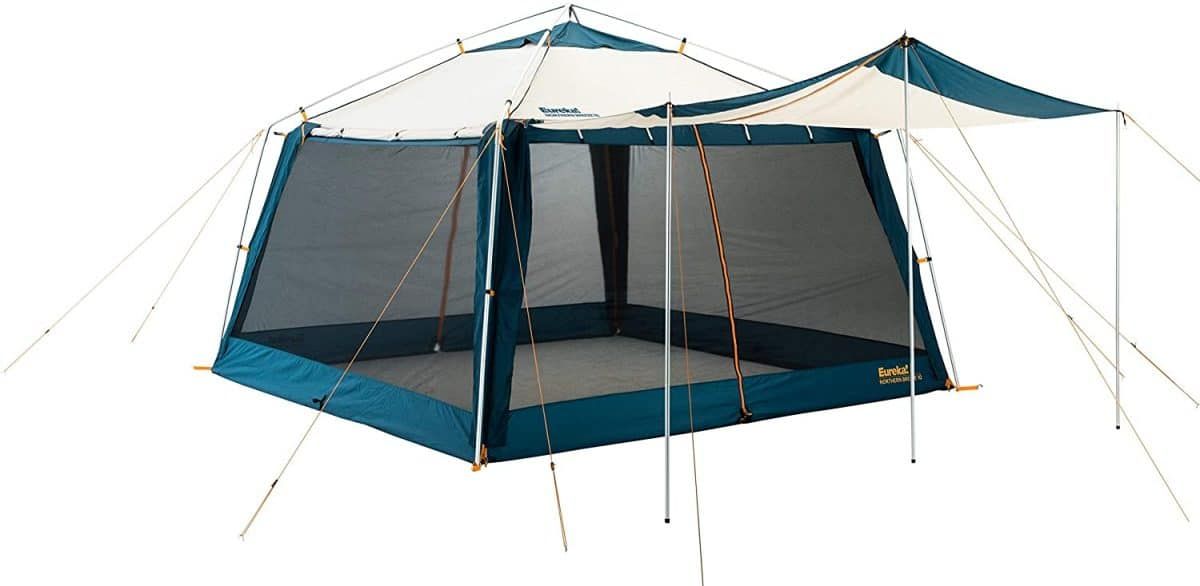
Star Rating: 5/5
Size: 100 sq ft
Peak Height: 7’8’’
Weight: 27.6 lbs
The Eureka Northern Breeze Aluminum Frame Screen House is the best screen house for rain for a few reasons.
For starters, this is a waterproof screen house (surprisingly a rare feature in camping gear). Plus, the roof area covers the whole body of the screen house, AND it comes with an awning.
I love an awing on a tent or screen house because it provides a great place to take off wet or muddy gear.
Oh, and this is a screen house with rain panels, meaning if it really starts pouring, you can let down waterproof sidewalls for maximum protection.
The fact that it has these optional sidewalls also makes it into a viable extra tent.
This screen shelter also has a super high center height at 7’8’’ and comes with a loop for a lantern in the middle.
The vertical sidewalls also mean you’re getting the entire 100 square feet of space to use.
One con to this little beaut is the price. It’s definitely higher than average.
Another thing to note is that this is a cabin-style screen house, meaning it’s a big block.
Eureka says that their heavy-duty aluminum cast poles hold up well in wind and rain, but gosh darn it, block-shaped tents just don’t always do well in high wind.
And especially with the rain panels down, wind can hit the side of the screen house and may cause some jostling.
That said, it still comes with guylines and pegs, so there’s that extra security there as well.
Read our guides on how to waterproof a tent and the best tent waterproofing spray.
PROS
- Waterproof
- Optional rain panels
- Very high center height
- Awning
CONS
- Expensive
- Square shape may not be ideal in high wind.
#6 NEMO Victory Screenhouse
Best for Wind
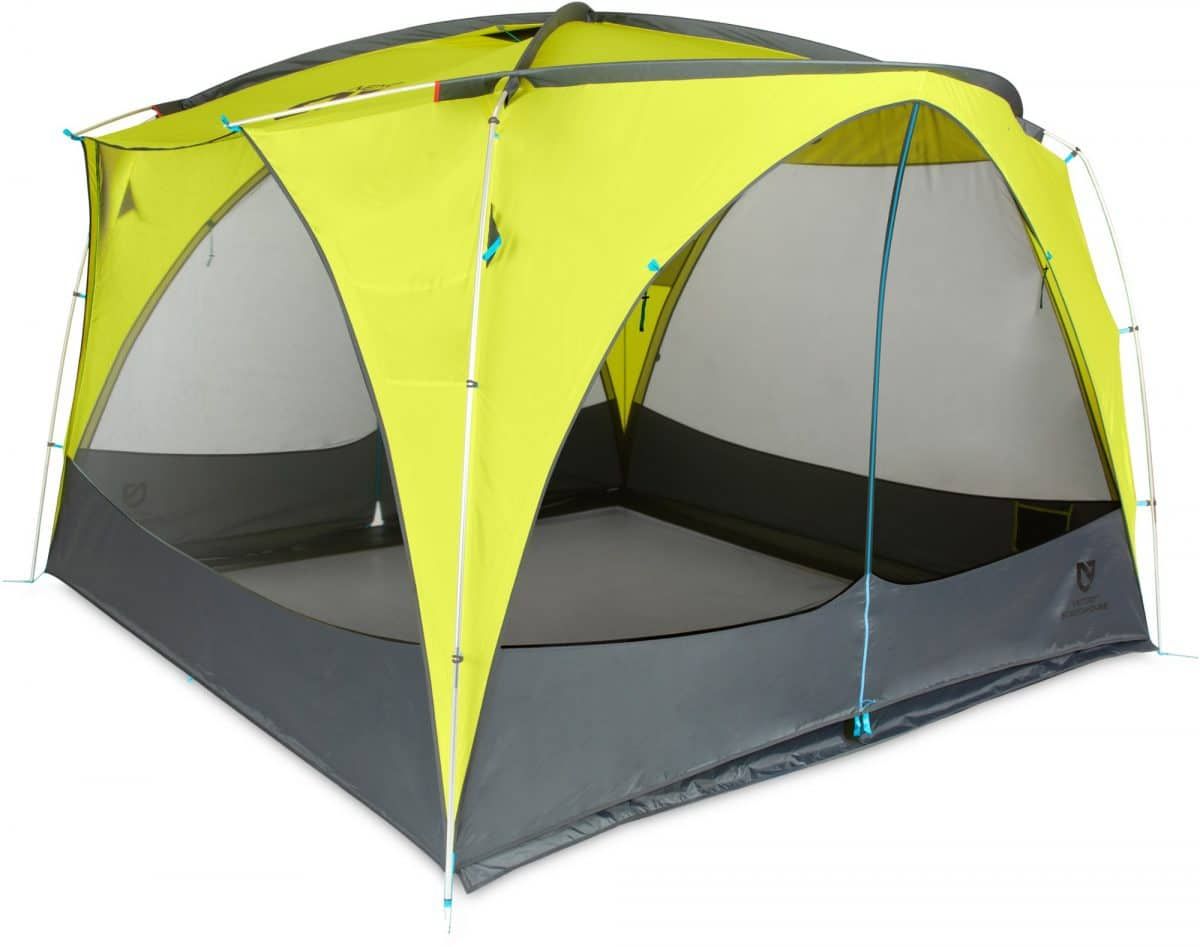
Our Rating: 4.9/5
Size: 100 sq ft
Peak Height: 7’1’’
Weight: 14.7 lbs
The NEMO Victory Screenhouse is one of the best screen houses for wind due to its rounded shape and extra tie-downs.
Another thing I really like about this product is that it’s also a great screen house for camping in the rain.
There are “rain gutters” that give rain a fast, efficient channel to flow off the top of the roof.
This screen house also has vertical mesh walls (yay for lots of space) and mesh pockets for organization (another yay).
NEMO also offers a lifetime warranty, so you know this is a high-quality product.
Additionally, the poles are made from aluminum, and there are two doors for easy access throughout the space.
This model also comes with an optional zip-in floor, but it’s not included (boo).
One slight downside to this screen house is the higher price. Additionally, the setup will likely go smoother if you watch a video first or read some reviews.
PROS
- Good in wind
- Rain gutters
- Mesh pockets
- Lifetime warranty
CONS
- High price
- Footprint not included
#7 CLAM Quick-Set Pavilion Gazebo Screen Tent
Best Screen House with Floor
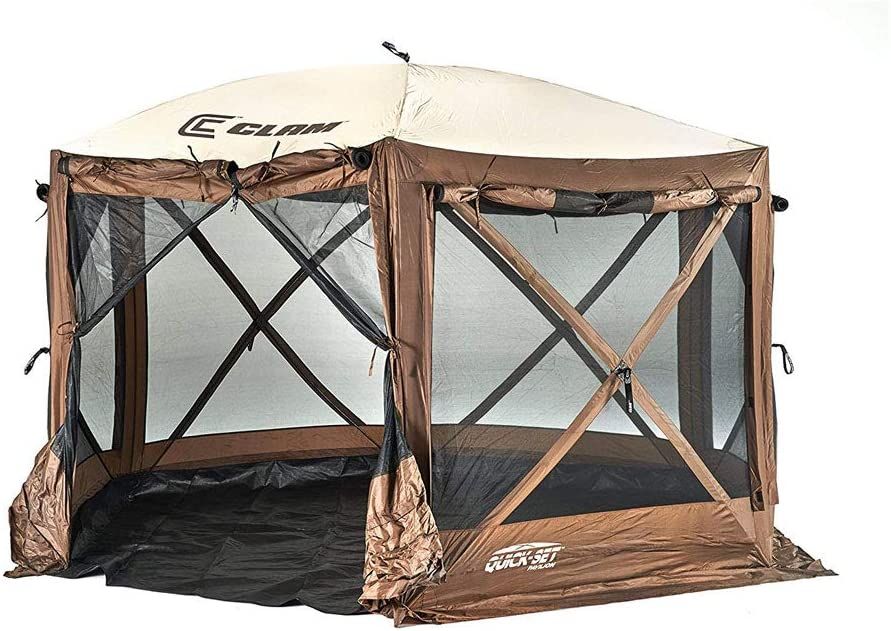
Our Rating: 5/5
Size: 156.3 sq ft
Peak Height: 6’8’’
Weight: 47 lbs
I chose the CLAM Quick-Set Pavilion as one of the best screen houses with a floor because, well, it actually has a quality floor that’s included in the price (which isn’t all that common).
The floor is also removable, which I like because it makes the screen house more versatile, and it comes with wind panels that roll down in bad weather.
This screen house is made from a 210 Denier poly-blend material, so it’s relatively heavy duty.
And the bottom of the tent comes with an extra-wide skirt to keep bugs out (which, let’s be honest, is the main reason people buy screen houses).
The setup on this monster shelter isn’t bad at all either, and it’s also pretty huge at 150+ square feet, so it’s definitely one of the larger screen shelters on this list.
The two downsides? It’s pricey and heavy at 47 pounds.
PROS
- Detachable floor
- Heavy-duty material
- Extra-wide skirt to keep bugs out
- Huge interior
- Easy setup
CONS
- Heavy
- Expensive
#8 Ozark Trail Instant Screenhouse
Best Budget Screen House

Our Rating: 3.5/5
Size: 100 sq ft
Peak Height: 7’
Weight: 17 lbs
Ozark Trail is a brand well-known for its affordable products, and this camping screen house is no different.
The Ozark Trail Instant Screenhouse is an affordable pop-up screen house with just under 100 square feet of usable space and lightweight construction.
This screen house is only 17 pounds, even with the steel frame, and it’s a good option for beginner campers looking for an easy screen house to set up.
The setup is fast, only taking 60 seconds, and features poles that are pre-attached to the frame.
Additionally, there are two doors for easy in and out access, and the heavy-duty polyester mesh does a great job of keeping the buggies out.
The roof material also has a 50 UPF sun protection rating, making it a good respite from the hot sun as well.
Due to the low price of this model, you probably can’t expect this screen house to be passed down to your grandchildren.
Although it’s fairly durable for the price, I’d still plan to only use it for calm summer camping.
Finally, you’ll have a little under 100 square feet of usable space due to the sloped wall design.
PROS
- Great bang for your buck
- Easy to set up
- Lightweight
CONS
- Sloped walls
- Lower quality materials
#9 Coleman Screened Canopy Tent With Instant Setup
Most Durable Screen House
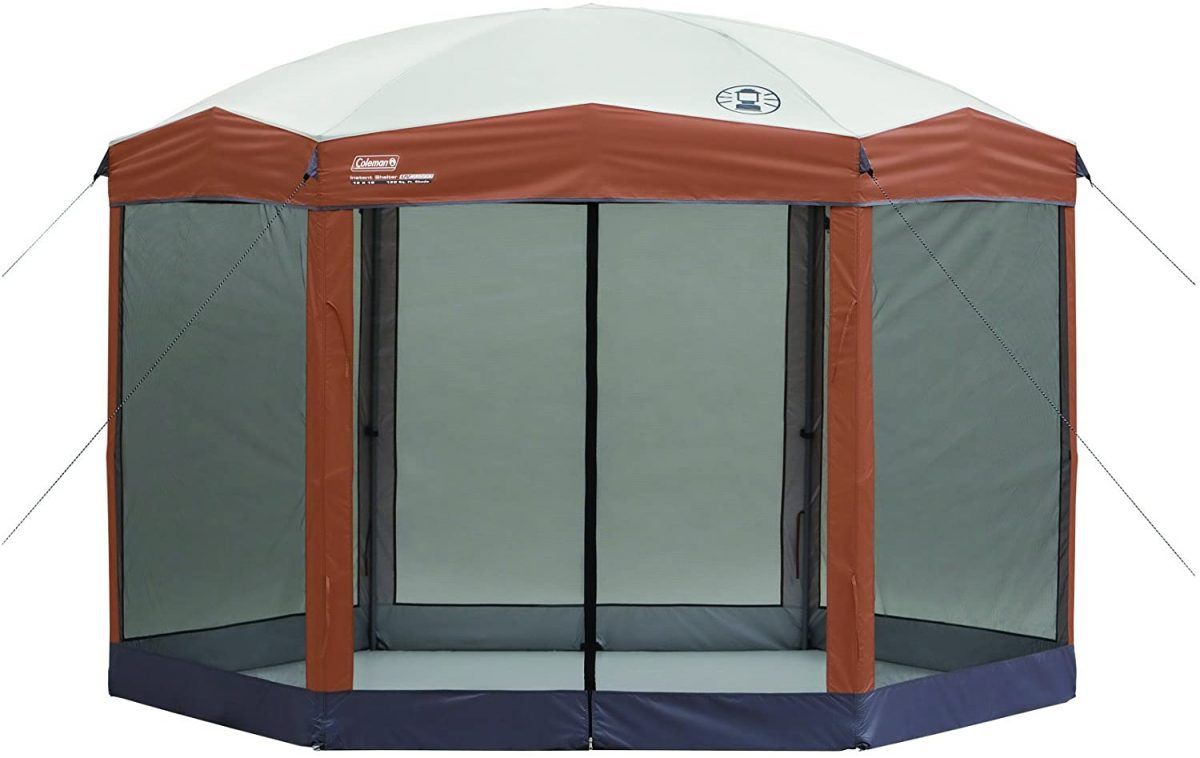
Our Rating: 5/5
Size: 90 sq ft
Peak Height: 8’4’’
Weight: 45.2 lbs
The Coleman Screened Canopy Tent is the most durable camping screen house because of its high-quality materials paired with its sturdy design.
One of the aspects that helps this screen house stand up so well is the six-sided shape. With that many sides, there are lots of anchor points and guylines to attach to the ground.
Additionally, the overall rounded shape helps deflect wind.
Now, this screen house is heavy, so while this helps it stay put against higher winds, it can also make it difficult to set up.
This shelter also has straight walls, which you know I love because no one feels comfortable while stooping.
One thing I also like about this screen house is the wheeled carrying bag (which helps relieve the high weight).
The one thing I’ll note is that this tent doesn’t hold up as well for continuous use, but frankly, none of these screen tents are designed to be permanent fixtures in your yard.
They’re generally designed for occasional use while camping.
PROS
- Durable
- Double-sided fabric
- Straight wall design
- Wheeled carrying bag
CONS
- Heavy
- No instant setup
#10 Wenzel Magnetic Screen House
Best Magnetic Screen House
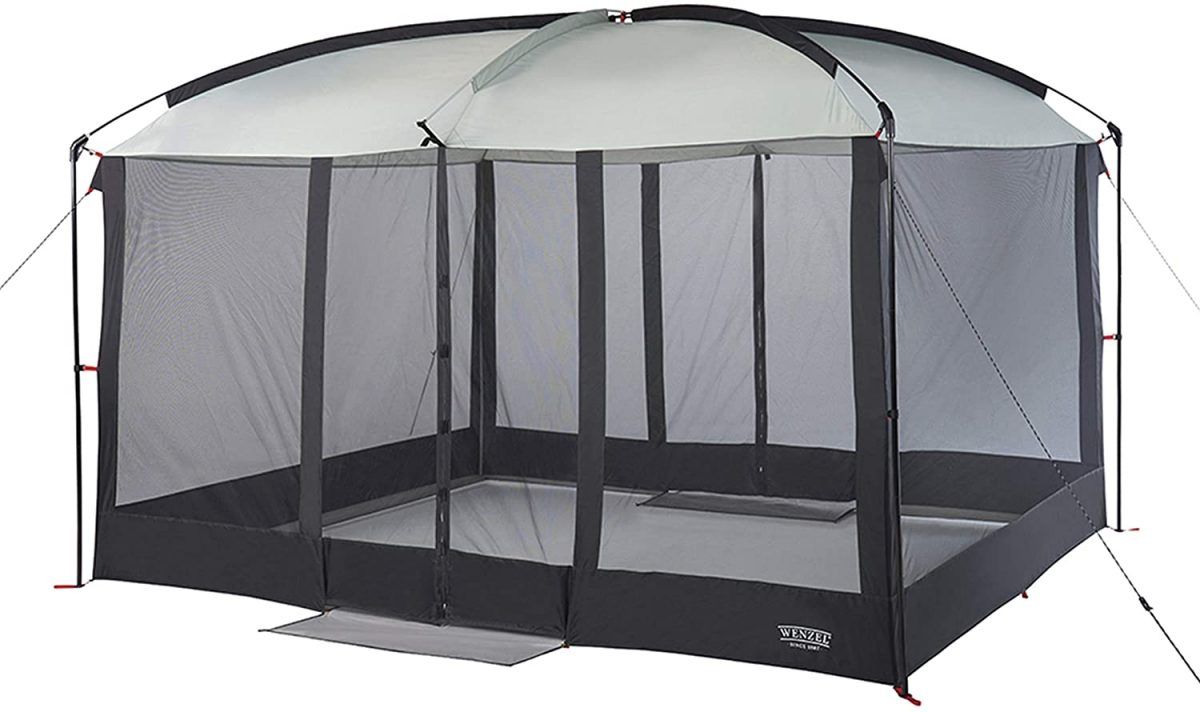
Our Rating: 3.5/5
Size: 99 sq ft
Peak Height: 7’6’’
Weight: 17 lbs 7 oz
A magnetic screen house uses magnets to keep the doors closed, which is nice because they’re super easy to open when you have your hands full.
The Wenzel Magnetic Screen House is a lightweight and large screen shelter with two magnetic doors.
The center height is very tall at seven and a half feet and features a straight wall design making it plenty big enough to fit over a picnic table.
One feature this screen house has that I haven’t seen elsewhere is an entry mat placed over the thresholds to prevent tripping over the edge of the tent.
This is a very reasonably priced tent, so expect to get what you pay for in some regards.
For one, the roof doesn’t support a lantern hanging loop. Also, the magnetic doors can sometimes open in strong wind, letting bugs in.
Finally, there’s no skirt on the Wenzel at the bottom, meaning that it must be placed on perfectly even ground to not have gaps at the base.
PROS
- Magnetic doors for easy entry
- Lightweight
- Low Price
- Tall height
CONS
- Must be placed on even ground
- Wind may open magnetic doors
#11 CAMPROS Screen House Room
Best for Backyard Camping
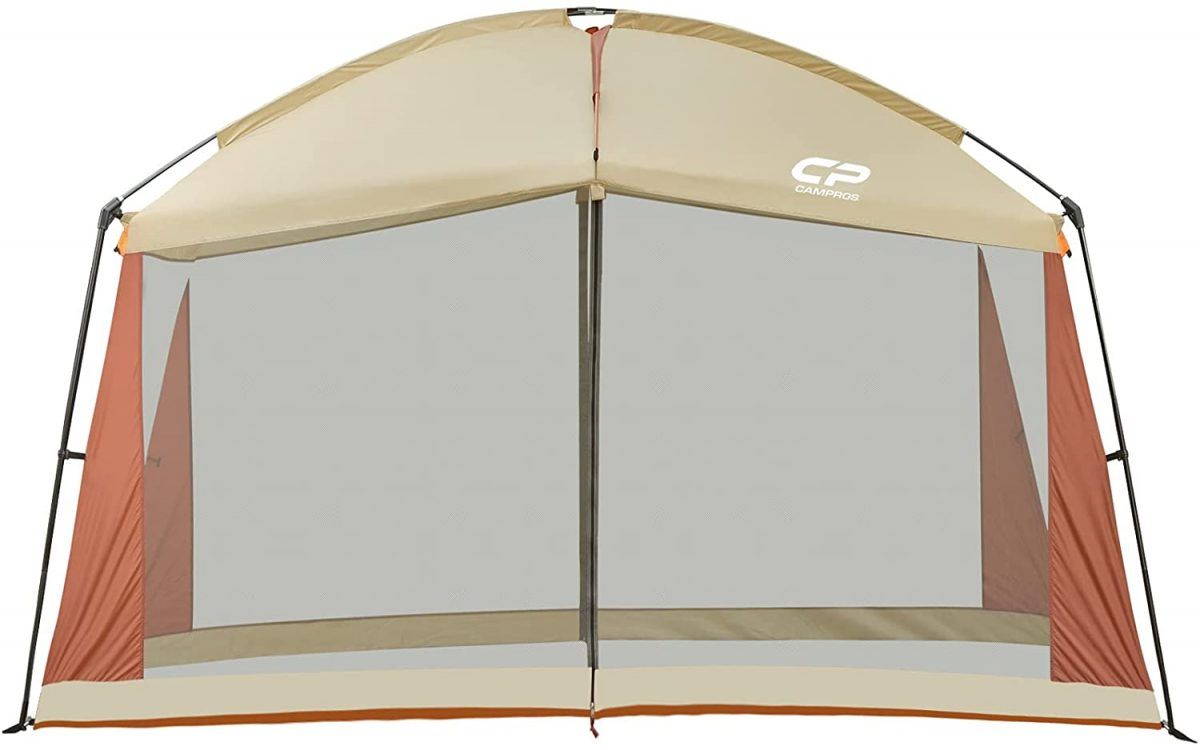
Our Rating: 4/5
Size: 120 sq ft
Peak Height: 7’6’’
Weight: 22.5 lbs
The CAMPROS Screen House Room is one of the best screen houses for backyard camping because it has a good intersection of price and quality.
After all, if you’re camping in the backyard, the worst-case scenario is you end up back in the house in your own bed.
This is one of the larger camping shelters at 120 square feet, and while the setup isn’t quite instant, most people can manage it in under 30 minutes with 2-3 people.
The CAMPROS screen house weighs 22 pounds, which is middle of the road compared to other shelters for camping.
The packed size is 25’’x 8’’x 8’’, which means it doesn’t take up much room in the car either, but the center height once assembled is very high (7’6’’).
It also conveniently has a skirt at the bottom to keep insects at bay.
Finally, the price makes it one of the best camping shelters for those on a budget.
The one downside is that the top of this tent is made from 190T (meaning 190 thread count) polyester, so while this should provide great sun protection, it may not be the most durable.
PROS
- Good quality for the price
- Very high center height
- Small packed size
- Includes skirt
CONS
- No instant setup
- Thread count could be higher
#12 Hasika All-Weather Diversified Screened Canopy
Best Screen House with Awning
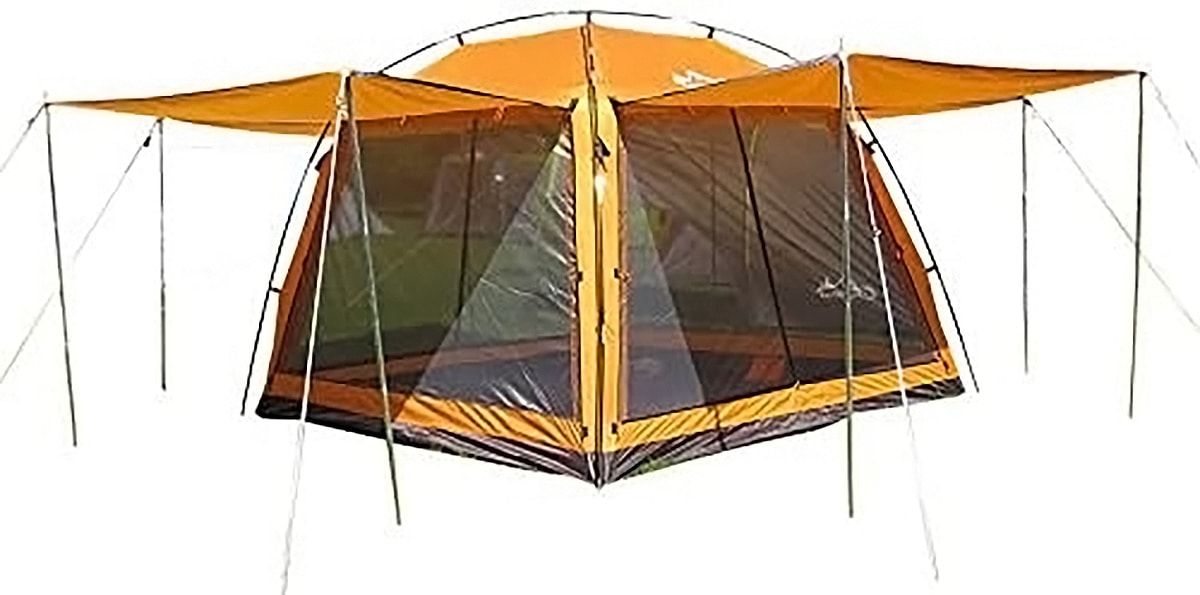
Our Rating: 4/5
Size: 64 sq ft
Peak Height: 8’
Weight: 12.8 lbs
The Hasika All-Weather Screened Canopy is the best shelter with an awning because it has an awning on all four sides of the tent!
And the canopy material is waterproof. It has a waterproofing rating of PU (polyurethane) 3000 mm (the minimum needed to be considered waterproof is 1000 mm).
The remainder of the shelter body is made of 150D polyesters (also reasonably heavy duty) with a PU 2000 mm waterproof rating.
This screen house is also very lightweight! It’s easy to set up with one person in under 10 minutes and comes with a floor.
The Hasika All-Weather Screened Canopy is also very reasonably priced.
However, it comes with one big caveat: the poles needed to set up the awnings don’t come with the screen house – those need to be purchased separately.
Finally, the interior size of the tent is relatively small at 64 square feet.
PROS
- 4 awnings
- Lightweight
- Waterproof, high-quality material
- Low price
- Fast set up
CONS
- Poles for awnings don’t come included
#13 EAST OAK Screen House Tent Pop-Up
Best Screen House for RV Camping
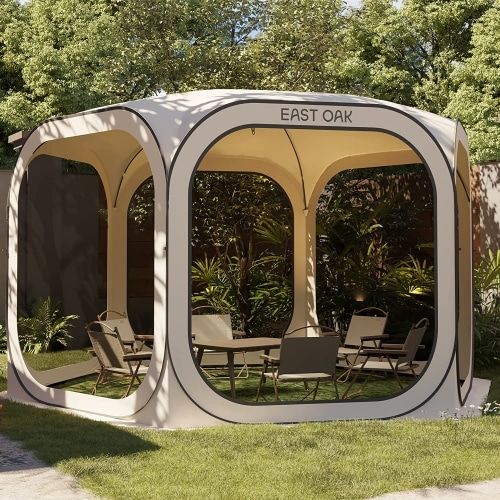
Star Rating: 5/5
Size: 94 sq ft
Peak Height: 7.9’
Weight: 29.8 lbs
The EAST OAK Screen House Tent Pop-Up is the Cadillac of screen tents and the best screen house for camping with an RV.
Whether you’re an RVer living out of your RV year-round, or you like making road trips all year, you need a big screened shelter to enjoy living partially outside.
The EAST OAK Screen House is giant, at 94 square feet, and makes an excellent dining tent for camping when the RV starts to get stuffy.
And unlike many other screen shelters, this one pops up in under a minute for last-minute use. The outer material is UV sun-protected, and there are large mesh windows for ventilation.
As with all Cadillacs, the downside is the price.
This is an expensive screen shelter. Take your time and compare it to the previously mentioned Alvantor Instant Screen House which has a similar build.
The nice thing is that both of these pack down flat. The EAST OAK is best for RVs though because it has flat walls that can be set up flush with the wall of your RV.
PROS
- Huge interior
- Sturdy design
- UV sun protection on the outside
CONS
- Expensive
- Heavy
Buying Guide: How to Choose the Best Screen House for Camping
What to Look for in a Screen House
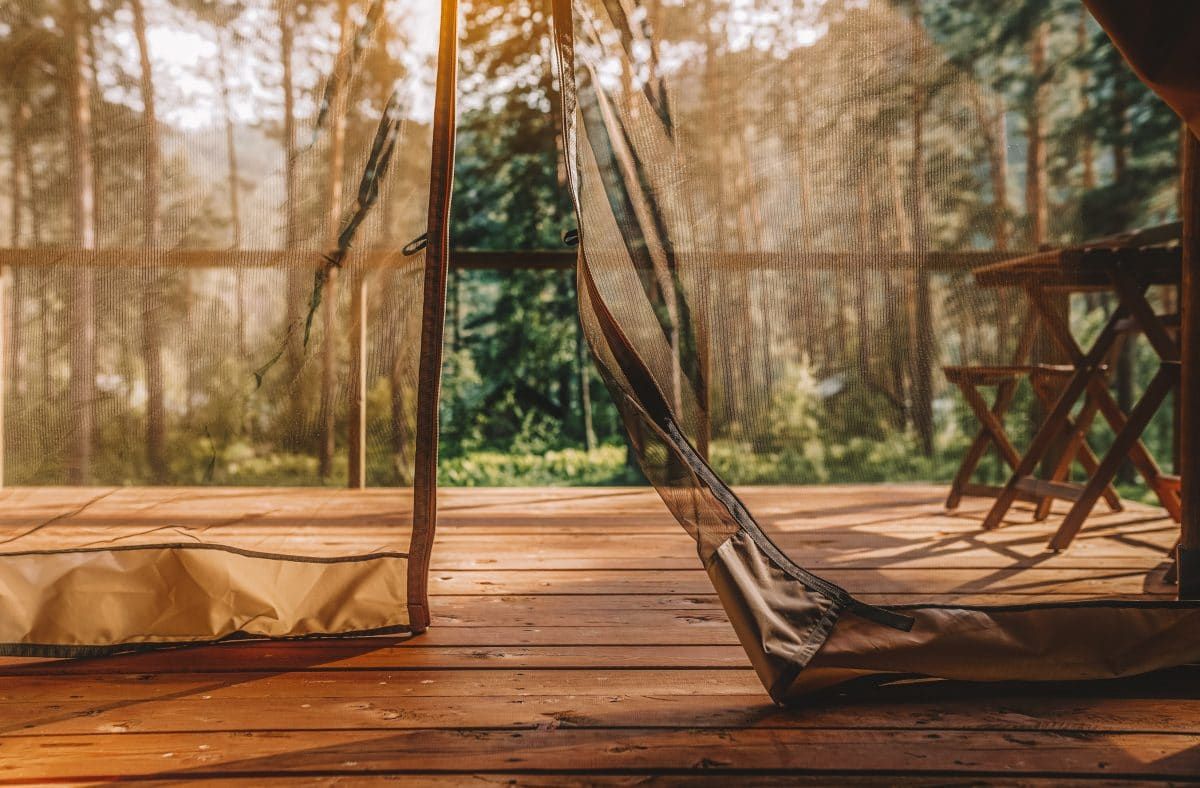
Size
Most shelters for camping have about 100 square feet of floor space.
This is the size that can fit over most picnic tables, so plan to be able to seat 4-8 adults under most screen houses for camping.
Peak Height
The peak height of a screen house is the height at the center of the tent structure. Most screen shelters have a height of around seven feet.
However, beware of tents with sloped wall designs.
The sloped wall means that the height at the edge of the tent is lower than the height at the peak and, in some instances, could be uncomfortably short.
Material Quality
Just because a manufacturer lists their materials as “heavy-duty” or “high quality” doesn’t mean they’re telling the truth.
Many manufacturers rely on customer ignorance and complicated spec details to hide that their material isn’t actually very durable.
Typically the roof of the shelter is made of a more durable material than the sides and body.
Don’t forget that mesh walls come in various thicknesses as well, which can influence airflow and visibility outside the tent.
Option for a Floor
Most screen houses don’t come with a floor, primarily because they’re intended to be popped over a picnic table.
However, some higher-end tents come with floors that you can zip into the rest of the screen house. These add an extra layer of protection if you’re not using a pre-established table.
Setup Time
Some screen houses feature instant, one-person setups, and some of them actually deliver on that promise!
Read the manufacturer’s details and reviews left by other customers to get an idea of how long it will take to set up your screen house.
Often, there will be a YouTube video tutorial on setting up your model of screen house if you need some extra help.
Skirt
The skirt (sometimes called a drape) is a solid piece of polyester that lines the bottom of the screen house and kind of looks like an extra flap all the way around.
Skirts on screen houses are incredibly useful. If you can’t set your screen house on perfectly level ground, the skirt will make up the difference in height and keep insects out.
Another way to use the skirt is to bury it (not all camping locations have this option, though), so the tent is completely anchored to the ground.
This adds a layer of insect protection and keeps the shelter from flying away.
Difference Between a Screen House and Tent
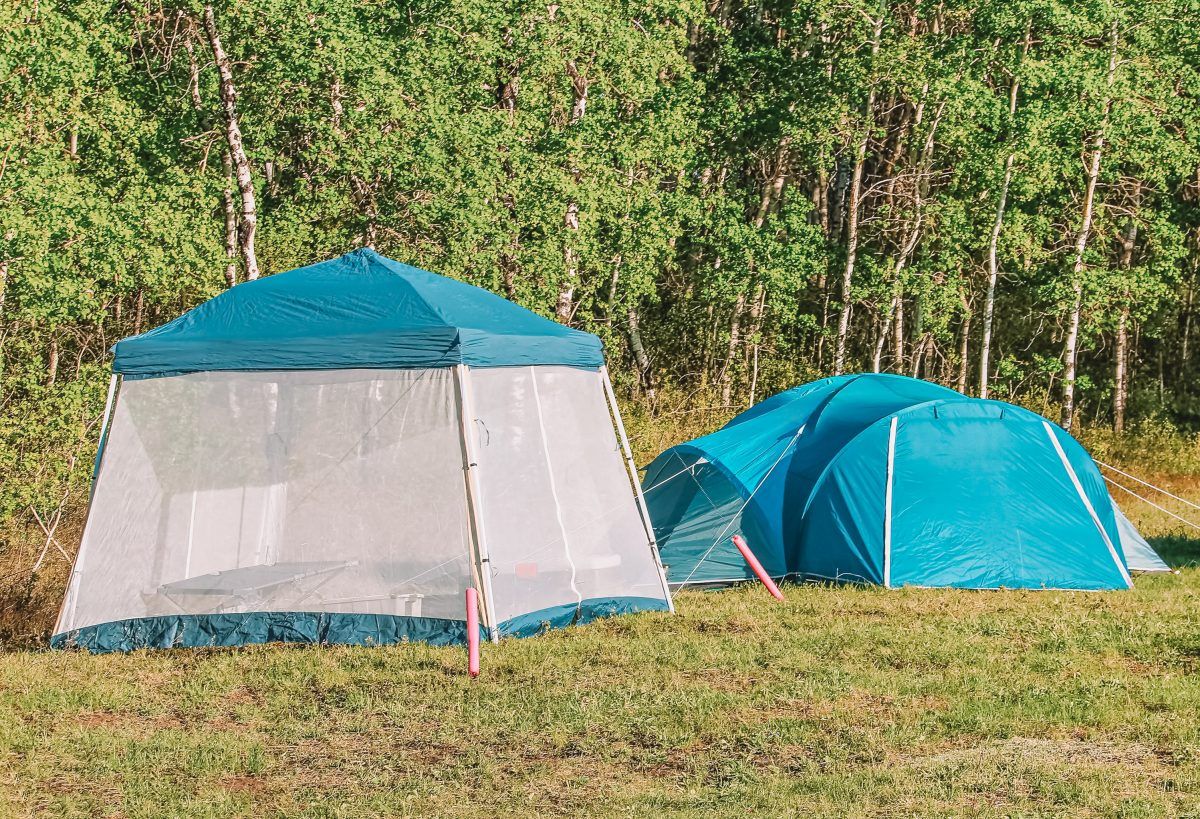
Screen house tent, screen shelter, or screen tent. All these terms get intermingled when talking about screen houses, but there’s a big difference between a screen house and a tent.
A screen house is built to be set up over a picnic table, and the primary function is to keep insects out and provide shade or mild rain protection.
Screen houses don’t often have floors and are more standard in shape and size.
A tent is designed to be slept in by one or more people and almost always features a floor.
It also has a rain fly for strong protection against wind and rain and comes in a wide variety of shapes and sizes.
Types of Screen Houses
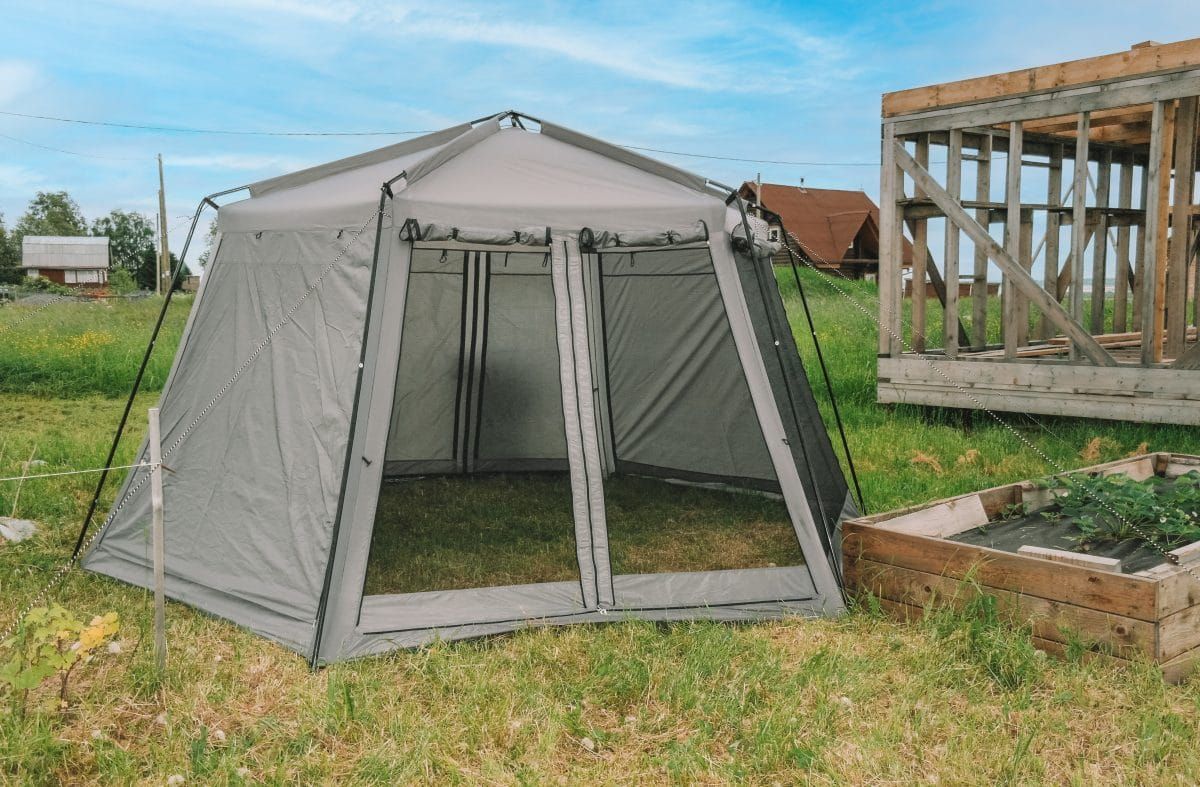
Straight Wall Screen Houses
Straight wall screen houses (cabin screen houses) have straight up and down walls.
These types of screen houses are often rectangular, but they can also be round or multi-sided.
Regardless of the shape, the straight wall design is nice because the height is uniform across the entire footprint of the screen house.
Straight wall screen houses are best for those who want to maximize the usable space inside the house.
Sloped-Wall Screen Houses
The sloped wall screen house simply has slanting walls. This design can sometimes mean that the entire footprint of the screen house isn’t very usable.
Dome-Shaped Screen Houses
Dome-shaped screen houses simply have a rounded design. The rounded design of the structure helps buffet wind and rain off the roof of the screen house.
Dome-shaped shelters may have shorter sidewalls as well. This shape of screen house is best for those who camp in rainy or windy areas.
FAQs About Screen Houses
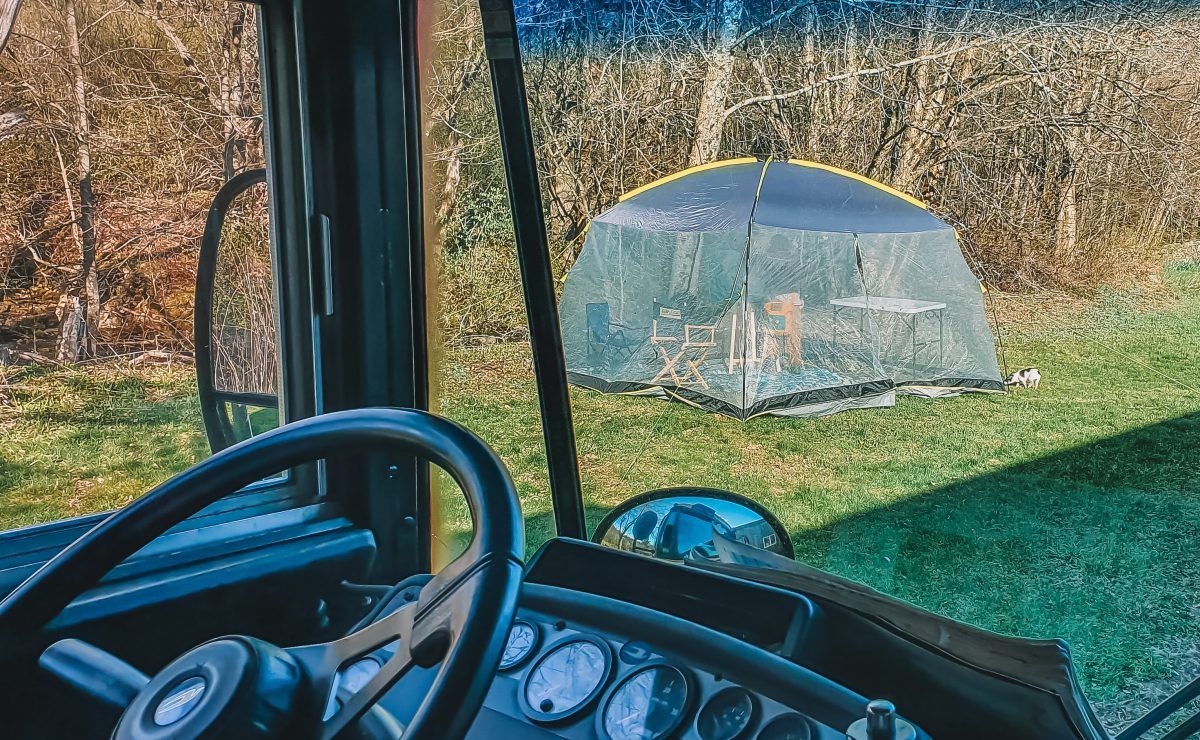
Are screen houses waterproof?
Screen houses can be waterproof depending on the type and thickness of the material used on the roof.
Look for screen shelters with sealed seams to increase the chances that the screen house is waterproof.
Can you sleep in a screen house?
Yes! You can sleep in a screen house. Many screen shelters offer excellent protection from insects and light rain.
However, don’t expect much privacy if you’re sleeping in a screen tent due to the mesh walls.
What is a screen house used for?
A screen tent is used to provide an extra insect-free, rain-free space around a picnic table while camping.
Do I need a screen house for camping? Are they worth it?
You don’t need a screen house for camping, but they can dramatically increase your comfort level if you intend to camp in a buggy area.
How much should I expect to spend on a screen house?
Screen houses vary widely in price, from under $100 to over $600. The average cost for a screen house is around $250.
Conclusion: Our Pick for the Best Screen House
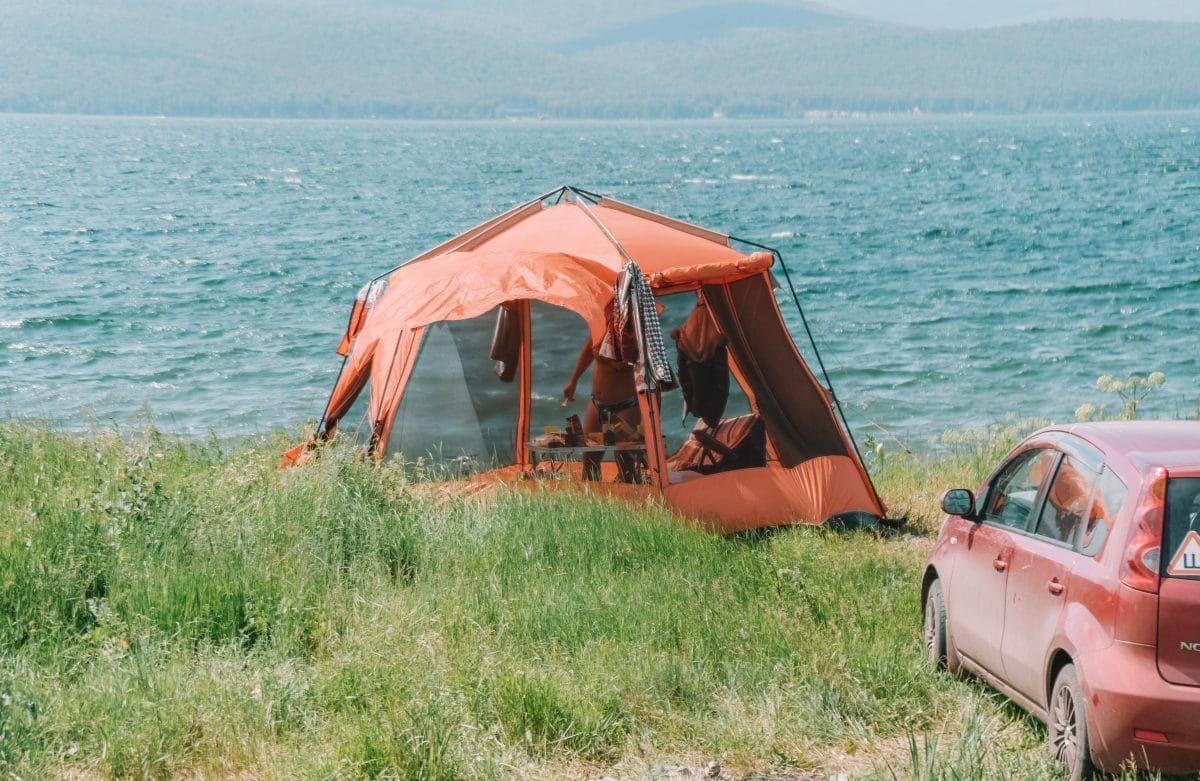
Our top pick for the best screen house is the Eureka Northern Breeze Aluminum Frame Screen House.
This screen house performs exceptionally well in the rain and has polyester panels that can be let down to make a completely enclosed structure.
Looking for camping tent recommendations? Check out our buying guides for the best 4-person tents, 6-person tents, 8-person tents, large family camping tents, 3-room tents, pop-up tents, instant tents, 10-person tents, 12-person tents, canvas tents, winter tents, cabin tents, insulated tents, waterproof tents, tents with a stove jack, tunnel tents, and inflatable tents.
ABOUT THE AUTHOR

Meredith Dennis
Meredith is a biologist and writer based in California’s Sierra Nevada. She has lived in six states as a biologist, so her intel on hiking and camping is *chef’s kiss* next level. One of her earliest camping memories was being too scared to find a bathroom at night on a family camping trip. Thankfully, she’s come a long way since then and she can help you get there too!
Looking for more outdoor gear recommendations? Check out our related posts below!
Best Hammocks with a Mosquito Net
Best Double Camping Cots for Camping
Best Heated Gloves for Cold Weather
12 Best Alternatives to Yeti Coolers
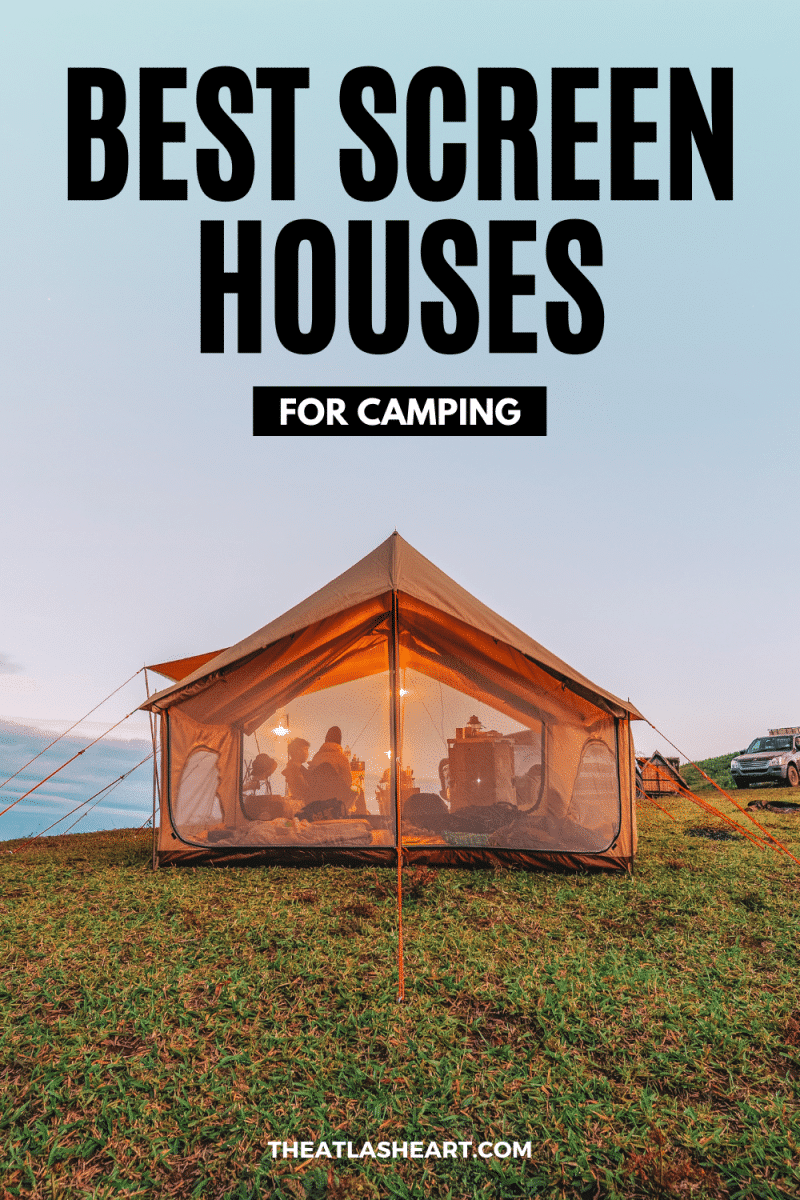

Pin one of these images for future reference

